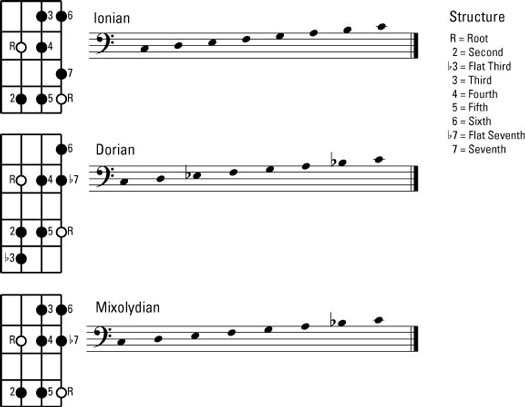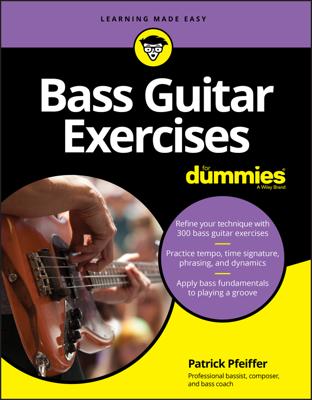The bass guitar is the foundation of any band, so playing a good bass groove can make or break a song. Here are a few guitar-playing guidelines to remember when you're creating a bass groove.
- Choose notes from the appropriate scale for the chord. Your note choice needs to correspond to each particular chord in the tune.
- Settle on a finger position. Try to choose notes for your groove that fit into a box (a pattern of notes on your fingerboard that requires no, or very little, shifting with your left hand). The less you shift your left hand, the easier it is to play the groove.
- Make your groove mobile. In most tunes, the chords change as the tune proceeds, which means that you have to move your groove to match the chord changes. Make sure you pick a group of notes that's simple to execute as you change chords.
The three most commonly used scales in a groove are the major, minor, and dominant scales. Chords are made up of the root, 3rd, 5th, and sometimes 7th of the scale they're related to. Figure 1 shows the structure of the major (Ionian), minor (Dorian), and dominant (Mixolydian) scales.

Figure 1: Common scales used for grooves (Ionian, Dorian, and Mixolydian).
Not all notes are created equal. Certain notes in a scale sound better in a groove than others. The following notes are the prime choices for your grooves (listed in order of importance):
- Root: The root is the most important note in a chord. A band counts on the bassist to define the sound of each chord. That's why bassists play the root as the first note every time the chord changes. Play that root with authority.
- 5th: The 5th reinforces the root, and it fits over any major, minor, or dominant chord. If you have a lot of chord changes between major, minor, and dominant in a tune, the root and 5 combination is the perfect choice for your groove.
- 3rd: The 3rd identifies the chord as either major or minor. Choosing the 3rd also forces you to settle on a hand position. If the chord is major and therefore requires a major 3rd, start your groove with your middle finger on the root in order to reach all the notes in the scale for that chord without shifting. If the chord is minor and therefore requires a minor 3rd, start the groove with your index finger on the root.
- 7th: The 7th is another excellent choice for a groove, especially if the chord is minor or dominant.
- 4th: The 4th is a great note to play as a passing note (an unstressed note that you play on your way to the next important note). Just be careful not to emphasize a passing note because it can obscure the chord.
- 6th: The 6th is a good choice as a passing note.
- 2nd: Avoid the 2nd except as a passing note.

